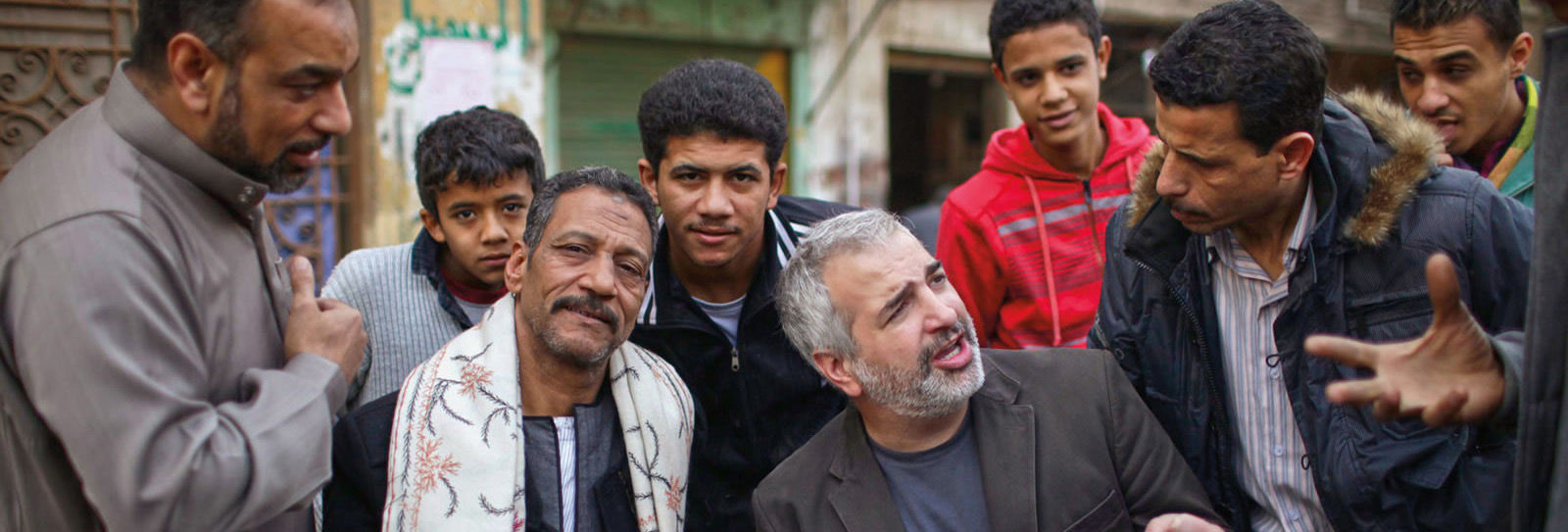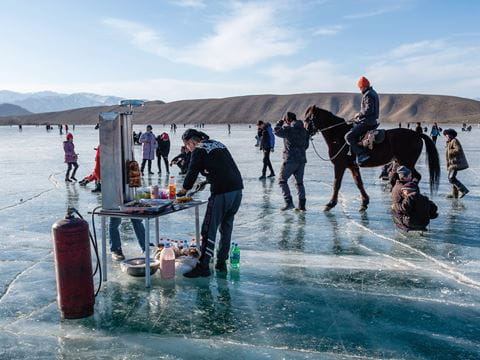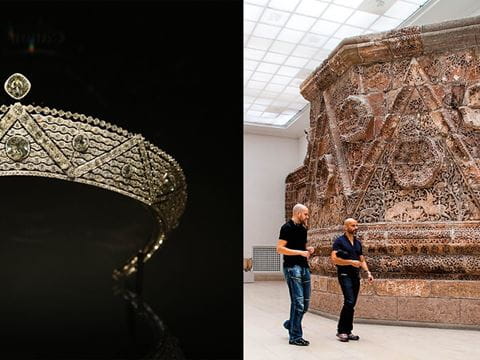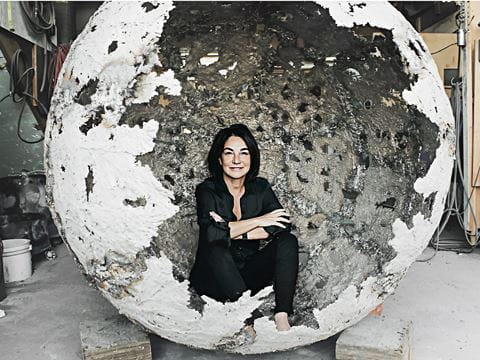
The Storyteller Who Listened
“I’ve tried to listen and understand,” said the late Anthony Shadid, the first Arab American correspondent to win a Pulitzer Prize in international reporting. How he did it was no secret formula: time; attention; sincerity—and lots of notes.
“One thing I’ve tried to do in covering the Arab world is never to tell someone they’re wrong. Instead, I’ve tried to listen and to understand.”
These words journalist Anthony Shadid wrote in April 2003 in accepting the annual George Polk Award for Foreign Reporting. He was 34 years old, an Arab American from Oklahoma City, and he wrote them from Baghdad, where weeks earlier he had begged his editors at The Washington Post to allow him to remain to cover the us invasion even as most global media personnel evacuated.
His focus in Iraq was on Iraqis—in homes, neighborhoods and workplaces. “Our responsibility as journalists to cover events is to witness historic events and bring meaning to them, to see how they impact ordinary people,” Shadid later recalled.
The next year, he would receive a Pulitzer Prize in International Reporting, the first Arab American to achieve the honor. He would earn a second in 2010 for work at The New York Times. Two years after that, crossing the mountains between Turkey and Syria, he would suffer a fatal allergic reaction to horsehair.

“Anthony showed us—reminded us—how a lone reporter can transform our understanding of history by revealing something true of human experience,” said Phil Bennett, one of his editors. Leading us media publication Columbia Journalism Review called Shadid “the most honored foreign correspondent of his generation.”
To gather a full picture of Shadid’s craft as well as his impacts on his profession and the role of Arab Americans in media, the American University of Beirut in 2017 began to study his personal papers and has conducted more than 50 interviews with Shadid’s friends and colleagues. These now offer records of both Shadid’s mind and his mechanics: why he insisted on covering the Mideast region so deeply from ground-level, human perspectives; how he captured what proved to be the trajectories and fates of countries in the words of ordinary people.
In many ways, his life was a story of an Arab American seeking connection to his roots while also seeking to tell an authentic story. During his youth in Oklahoma City and as a student first at the University of Oklahoma and later at the University of Wisconsin-Madison, he explored the legacy of his family that had migrated from Lebanon to the us in the 1920s. From that age he knew he wanted to become a correspondent in the Middle East. He recalled in 2001, “I got into journalism because I didn’t like how people wrote about the Middle East.” Explaining his approach, he said, “Understanding people’s humanity and keeping it at the center of stories is the most important thing in the way I work.”

In college he taught himself Arabic from cassette tapes. In his junior year, he spent the summer of 1989 as an intern at Al Fajr newspaper in Arab East Jerusalem. He spent a year in Cairo studying Arabic. After starting with the Associated Press (ap) in the us, he reached his goal in 1995 when the ap sent him to its Cairo bureau.
He referred often to how his draw to the region also was about “how gentle it could be in many ways. When you walk into a room anywhere in the Arab world, there is always a hello, always a sense of community, almost intimacy in how you deal with each other.” But in most reporting, he added, “I think this is often lost.”
He then moved in 2000 to The Boston Globe’s Washington, dc, bureau, and from there covered Arab- and Islamic-world politics in the capital and abroad. A story from those years particularly foreshadowed the profound impacts of his people-centered style.
Leila Fadel, now a National Public Radio (npr) correspondent, recalls how a story Shadid wrote from Ramallah, Palestine, explored how ordinary Palestinians felt living under Israeli occupation. It so struck her that she turned to journalism as a career. “I was 19 years old and in college, and had never, ever, read anything like this. I had never known exactly what I wanted to do until I saw this person doing it so boldly in this article.”
In her first job after graduation from Northeastern University, McClatchy news sent Fadel to cover Iraq—where she met Shadid. “He was a great mentor who was always ready to take a few minutes to answer a question or offer suggestions,” she remembers. “He was like a guide to us. He changed so many lives.”

Other young Arab American journalists whom Shadid assisted include Alia Ibrahim of Al Arabiya television; Hannah Allam of npr; novelist Alia Malek; Nour Malas of The Wall Street Journal; Ayman Mohyeldin of msnbc and Ashraf Khalil at the ap. They recall his tips: Focus on getting the essence of a story right; don’t waste time chasing big quotes; scan culture and arts pages of Arabic newspapers for story ideas and characters. Allam recalls Shadid telling her, “If you can say it better than the people you report on, then say it. Otherwise, let people speak for themselves.”
Colleague Anne Barnard says Shadid “looked at all people’s lives as having equal value…. His early work in Afghanistan for The Globe and then his Iraq reporting for The Washington Post opened the way for other correspondents to cover the region from all perspectives.”
Analysis of Shadid’s work shows three keys to his success: time, attention, and sincere caring. He spent hours and hours, sometimes days and weeks, listening to people—in a village in Iraq, in a café in Casablanca, in a struggling neighborhood in Cairo. People trusted him. People shared their innermost feelings with him.
“He never closed his notebook or put it down,” said one editor who worked with him in Iraq. Shadid ignored most press conferences. He preferred to wander, work local leads, because he knew that stories lay everywhere people lived and worked. He looked people in the eye, repeated their names several times, nodded to acknowledge their thoughts and wrote down every word they uttered while also cataloging physical items—clothes, beads, religious symbols, artwork, garden trees—that spoke to their identity. Nothing was too big or too small to mention—a discarded cigarette box, a vase of plastic flowers, old newspapers and faded books, broken windows, chipped paint, dried patches of blood on the sidewalk, a row of bmws in front of a trendy café.
When he finished reporting, he transcribed his notes and interviews, identified the theme and chose the words, gestures and actions of the main characters who would tell the story along with the settings. From these he scripted a detailed outline, along the way adding more comments, glances, hand gestures, or a long sad sigh or a laugh that would produce a short film of human actions, clothes, home decor, memories, worries, music and poetry. “We chronicle; we tell stories, and we try to understand,” he said.
When Shadid’s colleagues discuss what struck them most about his work they make references to no fewer than 10 art forms. His methodology mimicked oral history, one journalist said. Several colleagues described him as a poet. Some said he used the tools of a novelist or an author of vignettes. Others saw in his depictions the hand of a painter, or a photographer. In stories’ drama and action, there lay the work of a dramatist, a filmmaker, or a documentarian.
Shortly after Shadid’s death, Columbia Graduate School of Journalism Dean and former colleague Steve Coll wrote: “Anthony was always interviewing, nodding, and scribbling. He was respectful and humble, determined, sympathetic, emotional, clear, and professional. I remember thinking, ‘this is how a journalist should be.’ He taught us all, and he taught us about the things that matter most.”
About the Author

George Azar
George Azar is author of Palestine: A Photographic Journey (University of California, 1991), co-author of Palestine: A Guide (Interlink, 2005) and director of the films Beirut Photographer (2012) and Gaza Fixer (2007). He lives in Beirut.
Rami G. Khouri
Rami G. Khouri (@ramikhouri) is a journalist, internationally syndicated columnist and book author. He is a professor of journalism as well as Journalist-in-Residence at the American University of Beirut, where he is developing a course on the reporting methods of Anthony Shadid. He is also a nonresident senior fellow at the Kennedy School of Harvard University.
You may also be interested in...

Spotlight on Photography: Finding Frozen Fun in Kyrgyzstan
Arts
Culture
In the winter of 2020, Lake Ara-Köl in Kyrgyzstan was becoming more and more popular.
Cartier and Islamic Design’s Enduring Influence
Arts
For generations Cartier looked to the patterns, colors and shapes of the Islamic world to create striking jewelry.
Meet Sculptor Marie Khouri, Who Turns Arabic Calligraphy Into 3D Art
Arts
Vancouver-based artist Marie Khouri turns Arabic calligraphy into a 3D examination of love in Baheb, on view at the Arab World Institute in Paris.